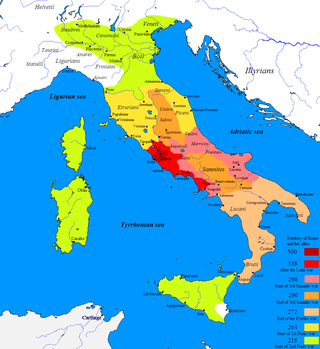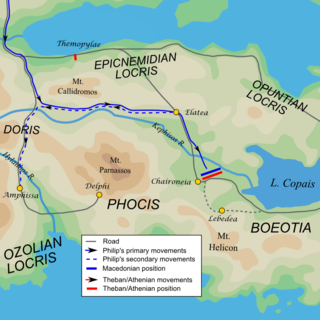Related Research Articles

Agathocles was tyrant of Syracuse from 317 BC and king of much of Sicily from 304 BC until his death. Agathocles began his career as a military officer, then raised his profile as a supporter of the democratic faction in Syracuse against the oligarchic civic government. His opponents forced him into exile, where he became a mercenary leader. Finally, he managed to make his way back to Syracuse and was elected general. A few years after this, he took power through a coup d'état. After this he was, in practice, a tyrant, although a democratic constitution theoretically remained in force.

Year 264 BC was a year of the pre-Julian Roman calendar. At the time it was known as the Year of the Consulship of Caudex and Flaccus. The denomination 264 BC for this year has been used since the early medieval period, when the Anno Domini calendar era became the prevalent method in Europe for naming years.

This article concerns the period 309 BC – 300 BC.
During the 290s BC, Hellenistic civilization begins its emergence throughout the successor states of the former Argead Macedonian Empire of Alexander the Great, resulting in the diffusion of Greek culture throughout the Levant and advances in science, mathematics, philosophy, etc. Meanwhile, the Roman Republic is embroiled in war against the Samnites, the Mauryan Empire continues to thrive in Ancient India, and the Kingdom of Qin in Ancient China, the one which in the future will conquer its adversaries and unite China, begins to emerge as a significant power during the Warring States period.
This article concerns the period 289 BC – 280 BC.
This article concerns the period 269 BC – 260 BC.
This article concerns the period 259 BC – 250 BC.
This article concerns the period 249 BC – 240 BC.

Year 250 BC was a year of the pre-Julian Roman calendar. At the time it was known as the Year of the Consulship of Regulus and Longus. The denomination 250 BC for this year has been used since the early medieval period, when the Anno Domini calendar era became the prevalent method in Europe for naming years.
Year 214 BC was a year of the pre-Julian Roman calendar. At the time it was known as the Year of the Consulship of Verrucosus and Marcellus. The denomination 214 BC for this year has been used since the early medieval period, when the Anno Domini calendar era became the prevalent method in Europe for naming years.
Year 215 BC was a year of the pre-Julian Roman calendar. At the time it was known as the Year of the Consulship of Albinus/Marcellus/Verrucosus and Gracchus. The denomination 215 BC for this year has been used since the early medieval period, when the Anno Domini calendar era became the prevalent method in Europe for naming years.
Year 240 BC was a year of the pre-Julian Roman calendar. At the time it was known as the Year of the Consulship of Centho and Tuditanus. The denomination 240 BC for this year has been used since the early medieval period, when the Anno Domini calendar era became the prevalent method in Europe for naming years.
Year 247 BC was a year of the pre-Julian Roman calendar. At the time it was known as the Year of the Consulship of Metellus and Buteo. The denomination 247 BC for this year has been used since the early medieval period, when the Anno Domini calendar era became the prevalent method in Europe for naming years.

Year 338 BC was a year of the pre-Julian Roman calendar. At the time it was known as the Year of the Consulship of Camillus and Maenius. The denomination 338 BC for this year has been used since the early medieval period, when the Anno Domini calendar era became the prevalent method in Europe for naming years.

Year 298 BC was a year of the pre-Julian Roman calendar. At the time it was known as the Year of the Consulship of Barbatus and Centumalus. The denomination 298 BC for this year has been used since the early medieval period, when the Anno Domini calendar era became the prevalent method in Europe for naming years.
Year 278 BC was a year of the pre-Julian Roman calendar. At the time it was known as the Year of the Consulship of Luscinus and Papus. The denomination 278 BC for this year has been used since the early medieval period, when the Anno Domini calendar era became the prevalent method in Europe for naming years.
Year 316 BC was a year of the pre-Julian Roman calendar. At the time, it was known as the Year of the Consulship of Rutilus and Laenas. The denomination 316 BC for this year has been used since the early medieval period, when the Anno Domini calendar era became the prevalent method in Europe for naming years.
Year 306 BC was a year of the pre-Julian Roman calendar. At the time, it was known as the Year of the Consulship of Tremulus and Arvina. The denomination 306 BC for this year has been used since the early medieval period, when the Anno Domini calendar era became the prevalent method in Europe for naming years.

The Mamertines were mercenaries of Italian origin who had been hired from their home in Campania by Agathocles, Tyrant of Syracuse and self-proclaimed King of Sicily. After Syracuse lost the Seventh Sicilian War, the city of Messina was ceded to Carthage in 307 BC. When Agathocles died in 289 BC it left many of his mercenaries idle and unemployed in Sicily. Most of them returned home but some, liking the climate and the prospect of adventure on a foreign island, remained. They played a major role in the lead-up to the First Punic War.
References
- ↑ Qian, Sima. Records of the Grand Historian, Section: Basic Annals of Qin.